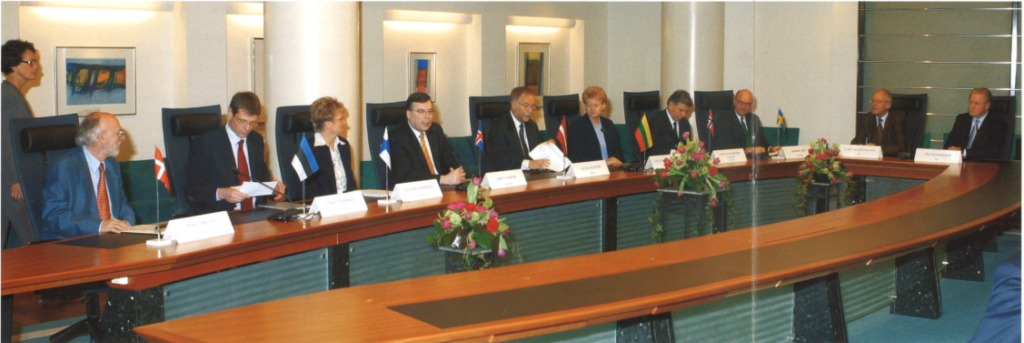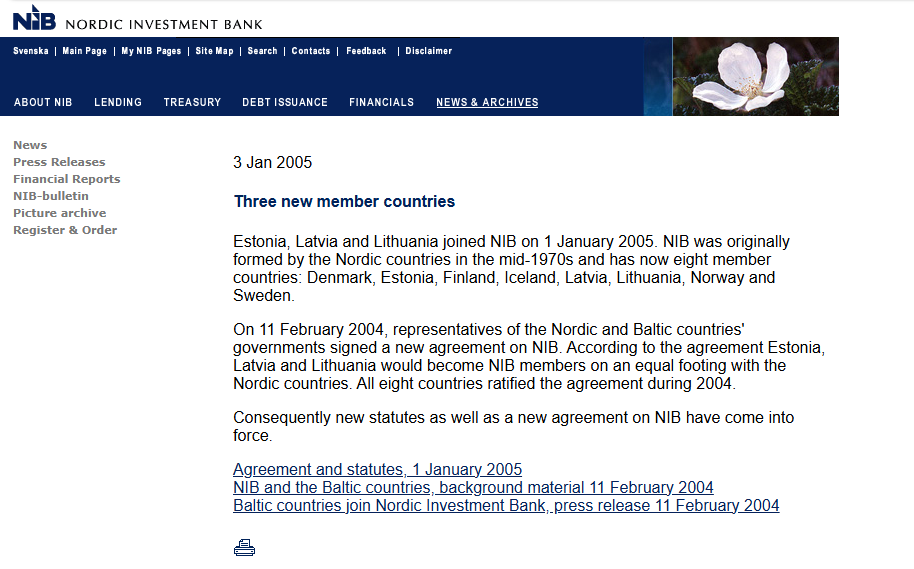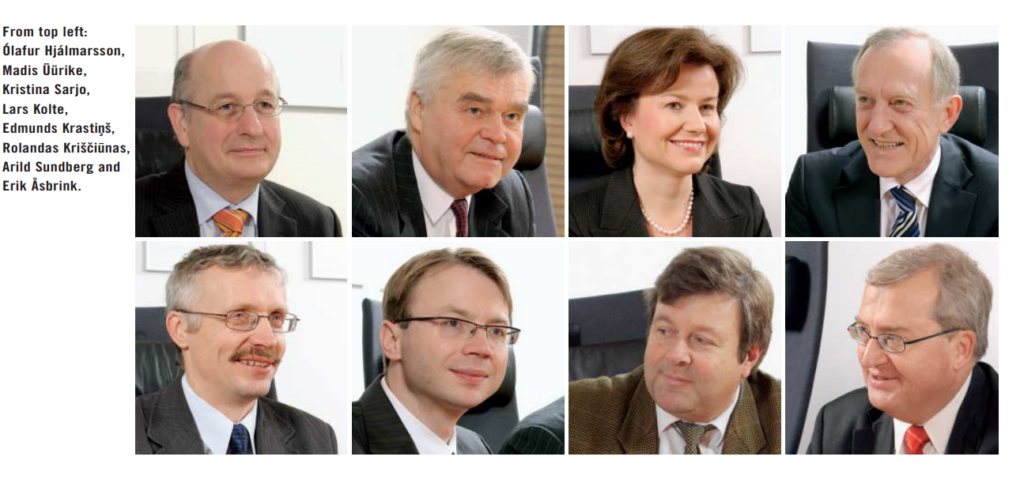
Baltic flags outside of NIB headquarters in Helsinki
1 Jan 2025
Estonia, Latvia, Lithuania: 20 years in the NIB family
Looking back on NIB’s history, one date stands out for the Baltics. On 1 January 2005, Estonia, Latvia and Lithuania joined Denmark, Finland, Iceland, Norway and Sweden as the Bank’s full-fledged members.
Yet, the true extent of a Nordic-Baltic financial institution goes far beyond this date. As we mark 20 years of the Baltics at NIB, key people behind the membership share their thoughts on what led to it and how it changed the Nordic-Baltic cooperation.
The Nordic star
The first pointers to a potential NIB-Baltic partnership date back to when the Bank was headquartered in a historic building on Unioninkatu, just between Helsinki’s two famous landmarks: the market and Senate squares.
“Already in the late 1980s, there were some signs that NIB could be interested in trying to identify investment projects in the Baltic countries, because they were seen as the most advanced republics of the Soviet Union,” remembers Siv Hellén, who joined NIB back in 1977.
After the Soviet collapse, the Baltics might have indeed been better off economically than other ex-communist countries. But there was still a long way ahead.
“It is not much help to be the best student in a very bad class,” says Jón Sigurðsson, NIB President during 1994–2005, in an interview. “On top of the poor economic conditions, the Baltics were facing serious environmental problems, because of polluting industries and inadequate and inefficient infrastructure in important areas such as house heating.”
Despite troubles, for the Baltics themselves, the path forward was clear. “When we regained independence, the Nordics were seen as a model that we would like to take as a benchmark – it was kind of a star where we would like to end up. That was the direction we were going,” says Rolandas Kriščiūnas, Permanent Representative of Lithuania to the OECD, reminiscing on the days long before he was part of the negotiations for the Baltic NIB membership.
From BIP to NIB
The Nordics held a similar vision – their governments felt that the development of the newly independent countries would bring benefits for the entire region. In 1992, NIB embarked on the Baltic Investment Programme (BIP) established by a joint Nordic-Baltic declaration. The programme was set-up to provide technical assistance to the management of newly created Estonian, Latvian and Lithuanian investment banks, resident advisors in the credit departments and hands-on training of staff.
Jón Sigurðsson says that the BIP had two main objectives: “to support the Baltic countries in creating an environment for privately owned businesses to replace the state-owned enterprises that were defunct; and to re-establish the trade and economic relations between the Nordic and Baltic countries that had been abrupt by the Soviet occupation.”
“I think it was very important. I liked the way NIB worked, which was not too politicized. Technically there was quite a lot to do, and the young people running and operating banks in Estonia needed help,” adds Madis Üürike, who was the Chair of the Board of the Estonian Investment Bank. To this organisation, he brought his previous experience from board positions at Swedish banks, together with a motto ‘trade not aid’.
Siv Hellén, NIB’s Senior Vice President and a General Counsel at the time, saw the developments of the BIP from both sides. Alongside her responsibilities in Helsinki, she took up an advisory role at the Estonian Investment Bank.
“From the very beginning, it was clear that the Baltic countries were interested in becoming members of NIB. They wanted much more visibility and an equal treatment by the international community,” she says.

“The staff of the Estonian Investment Bank felt that the Baltics didn’t want to be seen as developing countries,” remembers Siv Hellén. “I realised very quickly that if you want to have something done, you need to listen to their concerns.”
In her view, understanding the differences and learning to find bankable projects was essential in building the background required for the Baltic membership at NIB internally. “For this reason, I think the BIP was a success. For the three Baltic countries, it also helped to understand more about the international financial community.”
Part of the family
Echoing the feelings at the Estonian Investment Bank, the desire to be recognised as equal partners rather than aid receivers also pushed for more integration in the other Baltic countries.
“The general drive started when we saw that we need to really integrate ourselves into the democratic Western European structures,” says Rolandas Kriščiūnas when asked about the initial discussions about joining NIB.
“If you look back, Lithuania and other Baltic states had very clear instincts of security, part of which was the integration in every organisation, in every structure where we saw that we are part of the family. We wanted to become a part of the family.”
This wish was granted in June 2003, when the Nordic prime ministers agreed to invite Estonia, Latvia and Lithuania to become members of NIB. It took merely one and a half years from receiving the invitation to implementing all the necessary legal processes required to join the Bank.

In 2005, Madis Üürike became a member of NIB’s Board of Directors. He would hold this position until 2022, being the longest serving NIB board member to this day. “When we joined, the capital markets of the Baltic countries were non-existent. All the loans in the credit market were for short-term lending, so there was a ‘hole’ in the market,” says Madis as he remembers his early days at the Bank.
According to his Lithuanian colleague at the Board, Rolandas Kriščiūnas, the way the decisions are made at NIB reflects the values of the Nordic-Baltic region. “The fact that every country – despite different shares in capital – have the same number of votes is one of NIB’s strong features,” he says. “It speaks about the cohesiveness of the region, and that is also why we wanted to be a part of it.”
Their Latvian counterpart, Edmunds Krastiņš, shares a similar view on the motives of becoming NIB shareholders.
“It was just one year after Latvia had joined the EU and a large amount of investment and lending was flowing into economy. From that point, there was not much of a need for another financing source. The main argument for joining another international institution was about regional cooperation and integration, building stronger relations with Nordic countries.”
In good times and bad times
According to Edmunds Krastiņš, however, while the membership at NIB was not mainly built on financial reasons, being part of it proved to be vital when facing economic challenges. “As we know, the environment can change very quickly and already in 2009, when severely hit by global financial crisis, Latvia was looking for all possible financing.”

Remembering this period, Rolandas Kriščiūnas says that NIB provided crucial support to Iceland, Latvia, and Lithuania despite their increased risk profiles. “There was an issue of trust by international markets, but NIB stood behind us and helped us finance key projects which was quite difficult at that time. So, I think that our cooperation has been tested by crises.”
NIB’s stabilising role came into effect again in 2020, when the Bank swiftly extended COVID-19 response loans of EUR 750 million, EUR 500 million and EUR 400 million to Estonia, Latvia and Lithuania, respectively.
Overall, during the 20 years of membership, NIB signed around EUR 5.5 billion in financing agreements for some 160 projects in the Baltic countries, mainly related to infrastructure developments and energy transformation. Among the financed projects: new and modernised hospitals, better connectivity and cleaner transport, or more sustainable and independent power supply.
To stimulate these investments further, NIB set-up its second home based in Riga last year. While the Bank’s headquarters will remain in Helsinki’s Fabianinkatu, the Riga office will enable NIB to recruit and station workforce closer to its Baltic stakeholders. Symbolically, the Host Country agreement with Latvia was signed by NIB’s first Baltic president – Estonian André Küüsvek.